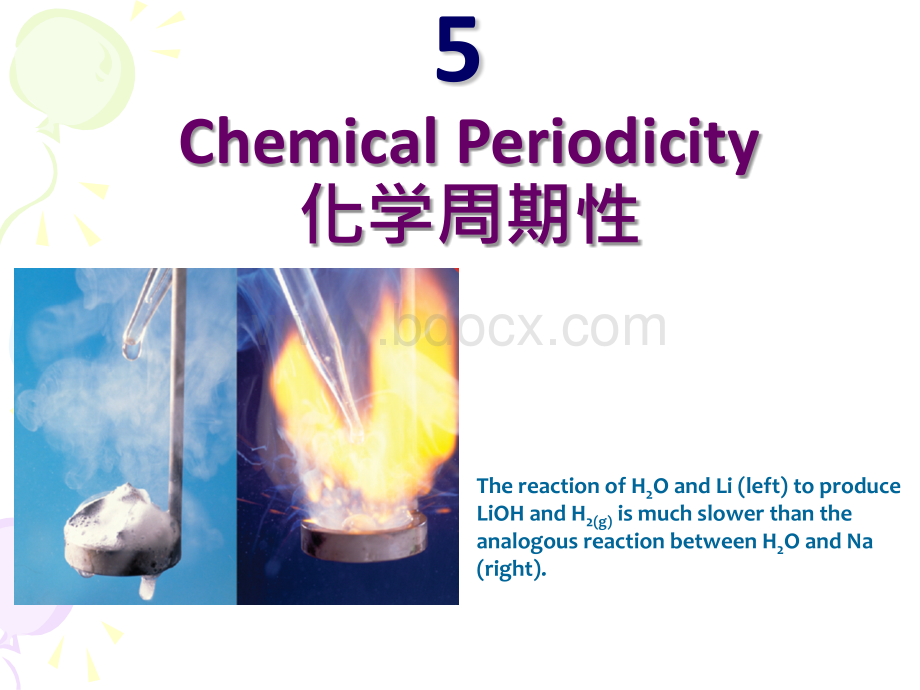chapter5-ChemicalPeriodicity(化学周期性)PPT格式课件下载.ppt
《chapter5-ChemicalPeriodicity(化学周期性)PPT格式课件下载.ppt》由会员分享,可在线阅读,更多相关《chapter5-ChemicalPeriodicity(化学周期性)PPT格式课件下载.ppt(80页珍藏版)》请在冰豆网上搜索。

5ChemicalPeriodicity化学周期性ThereactionofH2OandLi(left)toproduceLiOHandH2(g)ismuchslowerthantheanalogousreactionbetweenH2OandNa(right).ChapterGoals5-1MoreAboutthePeriodicTablePeriodicPropertiesoftheElements元素的周期特质5-2AtomicRadii原子半径5-3IonizationEnergy游离能5-4ElectronAffinity电子亲和力5-5IonicRadii离子半径5-6Electronegativity电负性5-7OxidationStatesChemicalReactionsandPeriodicity5-7Hydrogen&@#@theHydridesHydrogenReactionsofHydrogenandtheHydrides5-8Oxygen&@#@theOxidesOxygenandOzoneReactionsofOxygenandtheOxidesCombustionReactionsCombustionofFossilFuelsandAirPollution2MoreAboutthePeriodicTableEstablishaclassificationschemeoftheelementsbasedontheirelectronconfigurations.NobleGases钝气Group8AAllofthemhavecompletelyfilledelectronshells.Sincetheyhavesimilarelectronicstructures,theirchemicalreactionsaresimilar.nsns2npnp6He1s2NeHe2s22p6ArNe3s23p6KrAr4s23d104p6XeKr5s24d105p6RnXe6s24f145d106p63MoreAboutthePeriodicTableRepresentativeElements典型元素AretheelementsinAgroupsonperiodicchart.Theseelementswillhavetheir“last”electroninanoutersorporbital.Theseelementshavefairlyregularvariationsintheirproperties.4MoreAboutthePeriodicTabled-TransitionElements过渡金属元素ElementsonperiodicchartinBgroups.Sometimescalledtransitionmetals.Eachmetalhasdelectrons.ns(n-1)dconfigurationsTheseelementsmakethetransitionfrommetalstononmetals.Exhibitsmallervariationsfromrow-to-rowthantherepresentativeelements.5Firsttransitionseries(4sand3dorbitaloccupy):
@#@21Scthrough30ZnSecondtransitionseries(5sand4dorbitaloccupy):
@#@39Scthrough48CdThirdtransitionseries(6sand5dorbitaloccupy):
@#@52Laand72Hfto80HgFourthtransitionseries(6sand5dorbitaloccupy):
@#@89Acand104Rfto112MoreAboutthePeriodicTablef-transitionmetalsSometimescalledinnertransitionmetals.Electronsarebeingaddedtoforbitals.6Outermostelectronshavethegreatestinfluenceonthechemicalpropertiesofelements.AddinganelectrontoansorporbitaldramaticchangeinthephysicalandchemicalpropertiesAddinganelectrontoadorforbitalmuchsmallereffectonpropertiesPeriodicPropertiesoftheElementsAtomicRadii原子半径IonizationEnergy游离能ElectronAffinity电子亲和力IonicRadii离子半径Electronegativity电负性78AtomicRadii原子半径relativesizesAtomicradiiincreaseAtomicradiidecreaseAtomicradiidecrease=10-10m同周期典型元素大致随原子序增加原子半径愈小同族元素原子序增加原子半径愈大AtomicRadiiThereasontheatomicradiidecreaseacrossaperiodisduetoshieldingorscreeningeffect屏蔽效应.Effectivenuclearcharge有效核电荷,Zeff,experiencedbyanelectronislessthantheactualnuclearcharge,Z.最外层电子受原子的吸引力被内层电子对外层电子的排斥力给抵销即称屏蔽效应Movingacrossaperiod,eachelementhasanincreasednuclearchargeandtheelectronsaregoingintothesameshell(2sand2por3sand3p,etc.).Consequently,theouterelectronsfeelastrongereffectivenuclearcharge.ForLi,Zeff+1ForBe,Zeff+29有效核电荷镁的有效核电荷约为1210=2原子核质子数内层电子数总和原子半径随原子序数的增加呈现周期性变化。
@#@这与原子有效核电荷的周期性变化相关因为有效核电荷愈大,对外层电子的吸引力愈大,原子半径就愈小各周期的主族从左到右,电子层数不变,有效核电荷增加明显,原子半径的逐渐减少也就比较明显长周期中的过渡元素原子半径先是缓慢缩小然后略有增大内过渡元素,有效核电荷变化不大,原子半径几乎不变稀有气体原子半径突然增大,因为它是vanderWaals半径同一主族从上到下,由于电子层数增加,使遮罩效应明显加大,所以原子半径递增。
@#@11凡得瓦半径为两个相邻非键结原子间距离的一半AtomicRadiiExample5-1:
@#@Arrangetheseelementsbasedontheiratomicradii.Se,S,O,TeP,Cl,S,SiGa,F,S,AsCs,F,K,Cl6AOSSeTePeriod3ClSPSiFSAsGaFClKIE1Italwaystakesmoreenergytoremoveasecondelectronfromanionthanfromaneutralatom.2.IE1generallyincreasesmovingfromIAelementstoVIIIAelements.ImportantexceptionsatBe&@#@Mg,N&@#@P,etc.duetofilledandhalf-filledsubshells.3.IE1generallydecreasesmovingdownafamily.IE1forLiIE1forNa,etc.15DecreaseDecreaseincreaseincrease随原子序增大渐增趋势随原子序增大而递减同一族元素的游离能随原子序的增加而变小例如第1族元素的第一游离能大小顺序为:
@#@LiNaKRbCsFr同族元素的原子序愈大,原子半径愈大,最外壳层电子受原子核的引力愈小,故电子愈容易移除。
@#@游离能的周期性同一周期之各元素的第一游离能,随原子序的增加,呈现锯齿状的增加原子半径愈小,且有效核电荷愈大,所需的IE愈大同一周期第一游离2族3族,镁(738kJ/mol)铝(578kJ/mol)15(5A)16(6A),磷(1012kJ/mol)硫(1000kJ/mol)同一周期过渡元素,因原子半径及有效核电荷彼此差异不大,故其第一游离能彼此差异相对较小游离能的规则同一周期元素的第一游离能从左至右渐增,但在中间有些起伏IIAIIIA,而VAVIA:
@#@IIA(ns2)IIIA(ns2np1)是因为np能阶较ns高,因此IIIA原子的游离能较小VA(ns2np3)VIA(ns2np4)因为VA族的价电子组态为全半填满,而VIA族有一个p轨域填入两个电子,将增加电子的斥力,因此较易移去,故VAVIA19FirstIonizationEnergiesofSomeElements20Elementswithlowionizationenergies(IE)easilylosetoformcations(positivecharge)IonizationEnergyExample5-2:
@#@Arrangetheseelementsbasedontheirfirstionizationenergies.Sr,Be,Ca,MgAl,Cl,Na,PB,O,Be,NNa,Mg,Al,SiSrCaMgBeNaAlPClBBeONNaAlMg0energyisabsorbedIfelectronaffinity0energyisreleased对于放热愈多放热愈多的反应,我们称其电子亲和力愈大电子亲和力愈大,表示该原子愈易获得电子ElectronaffinityisameasureofanatomsabilitytoformnegativeionsSymbolically:
@#@25atom(g)+e-+EAion-(g)ElectronAffinity26Mg(g)+e-+231kJ/molMg-(g)EA=+231kJ/molBr(g)+e-Br-(g)+323kJ/molEA=-323kJ/molTwoexamplesofelectronaffinityvalues:
@#@Mostelementshavenoaffinityforanadditionalelectronandthushaveanelectronaff